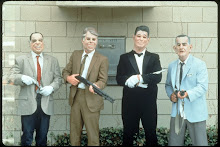skip to main |
skip to sidebar
Bodhi was right, he couldn’t paddle to New Zealand bro. He must be in Belize waiting on the hundred years storm. Expected to rise December 21, 2012.
Monday, May 26, 2008
The First Arab-American War
 At the dawn of the 19th century, a young and growing United States was quickly becoming a leader in transatlantic shipping. Southern plantations churned out tobacco, cotton and sugar thanks to ample land, and a burgeoning slave trade. Before asserting its independence from the Crown, these exports sailed under the watchful eye of the British Navy. Now alone, yet undaunted, U.S. ships took the treacherous voyages at the mercy of the high seas. As the trade routes reached the Mediterranean, American ships came under attack from the Barbary pirates. Left over from the Crusades, the Barbary pirates were a feared navy of Muslims that called the shores of North Africa home. Attacking all Christian ships, the pirates soon made life miserable for 3rd President Thomas Jefferson. In July of 1803, Jefferson, fed up with mounting losses, ordered the U.S.S. Philadelphia to restore order in the Mediterranean. Initially successful in recapturing an American vessel, the Philadelphia soon ran aground off the coast of Tripoli and was surrendered. Not wanting the spoils of war to be used against them, Lieutenant Stephen Decatur, Jr., led a group of men to the grounded ship and set it afire in the Tripoli Harbor. Occurring in 1806, the loss of the Philadelphia was only the end of the first act. The Second Barbary War lasted until 1815, when at last American ships could safely travel the southern Atlantic shores at the mouth of the Straight of Gibraltar. Free of piracy and tribute payments, the American agrarian export economy flourished until cotton was no longer king.
At the dawn of the 19th century, a young and growing United States was quickly becoming a leader in transatlantic shipping. Southern plantations churned out tobacco, cotton and sugar thanks to ample land, and a burgeoning slave trade. Before asserting its independence from the Crown, these exports sailed under the watchful eye of the British Navy. Now alone, yet undaunted, U.S. ships took the treacherous voyages at the mercy of the high seas. As the trade routes reached the Mediterranean, American ships came under attack from the Barbary pirates. Left over from the Crusades, the Barbary pirates were a feared navy of Muslims that called the shores of North Africa home. Attacking all Christian ships, the pirates soon made life miserable for 3rd President Thomas Jefferson. In July of 1803, Jefferson, fed up with mounting losses, ordered the U.S.S. Philadelphia to restore order in the Mediterranean. Initially successful in recapturing an American vessel, the Philadelphia soon ran aground off the coast of Tripoli and was surrendered. Not wanting the spoils of war to be used against them, Lieutenant Stephen Decatur, Jr., led a group of men to the grounded ship and set it afire in the Tripoli Harbor. Occurring in 1806, the loss of the Philadelphia was only the end of the first act. The Second Barbary War lasted until 1815, when at last American ships could safely travel the southern Atlantic shores at the mouth of the Straight of Gibraltar. Free of piracy and tribute payments, the American agrarian export economy flourished until cotton was no longer king.
Subscribe to:
Post Comments (Atom)
Post Comments (Atom)
Tallest Trees
Labels
-
Politics
(73) -
Hotties
(55) -
U.S. History
(44) -
Brunettes
(42) -
Blondes
(33) -
Criminal Law
(32) -
Bad History
(28) -
Barak Obama
(28) -
College Football
(27) -
Ex Presidents
(20) -
NFL Football
(20) -
Consumerism
(19) -
People on TV
(19) -
Racism
(19) -
Scandals
(18) -
Black Sunglasses
(15) -
Old Skool
(15) -
Polls
(15) -
Hip Hop
(14) -
Maps
(14) -
Miami
(14) -
The South
(14) -
Baseball
(13) -
Immigration
(13) -
Latin America
(13) -
Cable News Babes
(12) -
John McCain
(11) -
George Bush
(10) -
Hillary Clinton
(9) -
Irony
(9) -
Cuba
(8) -
Man of the Week
(8) -
Nebraska
(8) -
Fidel Castro
(7) -
Lady of the Week
(7) -
NBA Basketball
(7) -
Bill Clinton
(6) -
Photographs
(6) -
Stop Snitching
(6) -
The Failures of Corporate Media
(6) -
Drugs
(5) -
Gingers
(5) -
Alessandra Ambrosio
(4) -
Gangs
(4) -
Utah Style
(4) -
Hippies
(3) -
Jay Z
(3) -
Jessica Alba
(3) -
Mélissa Theuriau
(3) -
Penelope Cruz
(3) -
The Game
(3) -
The Great State of Florida
(3) -
Che Guevara
(2) -
Elizabeth Hurley
(2) -
Jackie Guerrido
(2) -
Lebron James
(2) -
Morocco
(2) -
Salma Hayek
(2) -
Spain
(2) -
50 cent
(1) -
Adrianna Costa
(1) -
Atticus Finch
(1) -
Bo Jackson
(1) -
Bob Dylan
(1) -
Bob Marley
(1) -
Bohemian Club
(1) -
Camino de Santiago
(1) -
Cayman Islands
(1) -
Dr Dre
(1) -
Gisele
(1) -
Irv Gotti
(1) -
Ja Rule
(1) -
Jam Master Jay
(1) -
Larry Bird
(1) -
Lil Kim
(1) -
Links
(1) -
Mark Twain
(1) -
Olympics
(1) -
Orange Bowl
(1) -
Queen Rania
(1) -
Robin Meade
(1) -
Snoop Dogg
(1)
Amigos de Blog
Blog Archive
-
►
2009
(26)-
►
December
(15)- Feliz Navidad
- The Blue Pill State
- Inked State Pride, Second Edition
- December 21, 2009…
- Try again Oscar
- 2009 Weather Girl of the Year?
- Sean Taylor Murder Trial
- The Most Awkward Christmas Photo Ever
- Lightsaber
- Who’s got the better tailgating coeds?
- The 4 Point Stance Heisman Pose
- Jealousy is a stinky cologne
- Schadenfreude Tebow Style
- Mac vs. PC
- 116 Felony Convictions
-
-
▼
2008
(212)-
▼
May
(87)- John McCain vs. Ageism
- Old School Conservation
- On the road again
- Globalization of the empty stomach
- The Girls from Ipanema
- Saul Alinsky and the 2008 Democratic Party
- While I was reading Beckett Magazine, others read …
- Numero Uno Beefcake
- Utah’s Guide to Summer Style
- Coveted Intangibles in College Football
- The First Arab-American War
- Obama’s Heavyweight Bouts
- May 24, 1941
- Memorial Day Weekend kicks off with ladies in whit…
- Toucan Sam
- He was sensitve to the word “bald”
- Constitutional Candidates?
- Shaved Domes and Beards must be “in”
- What’s the cushiest job in sports?
- Wonderful
- People I don’t understand
- College Football Unplugged
- Financial pinches lead to willing snitches
- Deliberations on Urination
- Giambi’s Whaletail
- Your reputation precedes you
- Where’s the Beef?
- El Fin de Semana
- The Nail in the Coffin
- Yellow Journalism
- Cable News Babes of the Week
- Snitches on Rocky Top
- The Changing Face of Beauty
- Off the market
- Hello DNC, meet the BCS
- The Most Honest Man in America?
- Silence please
- The GOP’s Silver Bullet
- A Bevy of Blondes
- Hip Hop Machismo
- The one thing Oklahoma and the Philippines have in…
- Granola Games
- When Old School beats New School
- Blogging and Jogging
- Rubber Euphemisms
- A legend passed too early
- Commercial Babes
- Tent City, It’s Dark and Hell is Hot
- First Bride Jenna Bush
- The Ugliest Uniforms in College Football
- Solar Moments
- Taurean Charles, Year of the Bull
- The Thin Line Between Freedom Fighter and Terroris…
- Two fake movie products I want to buy
- Making the most of it
- More Self Shots
- Doctors pushing products that harm
- VE Day
- Snitching in Paradise
- Goddesses in Green
- N.W.A. and Nirvana
- What is it with these self-pics?
- What do a Trekkie and the Coach of Da Bears have i…
- World’s 12th Highest Standard of Living
- Lindsay Lohan
- It’s raining lawsuits at the Weather Channel
- Siblings are Strange
- Border Traffic
- Lookin’ Fine in Yeller
- Did Pete Rose see it coming?
- Indiana and North Carolina
- First Lady Laura Bush
- Cinco de Maya
- Go Cougars
- No Schlitz
- Salma Hayek, A Great Mexican-American
- Pillow Talk Politics Addendum
- American Culture is a Recycling Bin
- Wingman
- Hall of Fame Athletes and Statuatory Rape
- Weather hotties from across the pond
- Thomas “Stonewall” Jackson
- Green Bikinis can do no wrong
- Pillow Talk Politics
- The Prescience of The Graduate
- Scarlett Johansson’s pearl necklace
- Misguided Vigilante Justice
-











1 comments:
Véra
said…
Dear Sir,
Our publishing team “Les Editions du Cherche Midi” (France) is currently working on a book project entitled “L’Europe à la carte”, with J-C Bas as its author. We are interested by the reproduction of the illustration quoted with the following reference :
“The First Arab-American War” / “Barbary Map”
found on FlickR and your blog.
The book will be composed of 50 pictures and illustrations which will be commented upon by international key figures who will share their vision of Europe.
We would be very grateful if you could advise us on how to get the illustrations with a resolution of 300 dpi in a 21X29,7 size, jpeg format, with a view to publish them. The final work will be published to a number of 3000 copies in both French and English languages.
We would like to stress the fact that we are runing short on time, and would be very pleased to get an answer as soon as possible.
We thank you in advance for giving us particular details on how you could produce the illustrations (Ftp server, Cd or mail to our studio), how the copyright applies, and what the copyright conditions are.
I am available in case you would need any further information.
Best wishes,
Véronique Pret
Iconographer for “Le Cherche-Midi” Publishing Company
13-15 rue Amelot
75 011 Paris
0331 73 71 68 73
0336 83 65 68 35
May 11, 2009 7:08 AM
Post a Comment